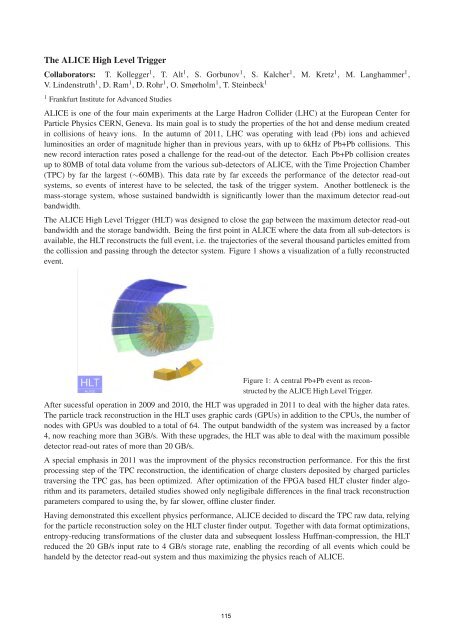FIAS Scientific Report 2011 - Frankfurt Institute for Advanced Studies ...
FIAS Scientific Report 2011 - Frankfurt Institute for Advanced Studies ...
FIAS Scientific Report 2011 - Frankfurt Institute for Advanced Studies ...
Create successful ePaper yourself
Turn your PDF publications into a flip-book with our unique Google optimized e-Paper software.
The ALICE High Level Trigger<br />
Collaborators: T. Kollegger 1 , T. Alt 1 , S. Gorbunov 1 , S. Kalcher 1 , M. Kretz 1 , M. Langhammer 1 ,<br />
V. Lindenstruth 1 , D. Ram 1 , D. Rohr 1 , O. Smørholm 1 , T. Steinbeck 1<br />
1 <strong>Frankfurt</strong> <strong>Institute</strong> <strong>for</strong> <strong>Advanced</strong> <strong>Studies</strong><br />
ALICE is one of the four main experiments at the Large Hadron Collider (LHC) at the European Center <strong>for</strong><br />
Particle Physics CERN, Geneva. Its main goal is to study the properties of the hot and dense medium created<br />
in collisions of heavy ions. In the autumn of <strong>2011</strong>, LHC was operating with lead (Pb) ions and achieved<br />
luminosities an order of magnitude higher than in previous years, with up to 6kHz of Pb+Pb collisions. This<br />
new record interaction rates posed a challenge <strong>for</strong> the read-out of the detector. Each Pb+Pb collision creates<br />
up to 80MB of total data volume from the various sub-detectors of ALICE, with the Time Projection Chamber<br />
(TPC) by far the largest (∼60MB). This data rate by far exceeds the per<strong>for</strong>mance of the detector read-out<br />
systems, so events of interest have to be selected, the task of the trigger system. Another bottleneck is the<br />
mass-storage system, whose sustained bandwidth is significantly lower than the maximum detector read-out<br />
bandwidth.<br />
The ALICE High Level Trigger (HLT) was designed to close the gap between the maximum detector read-out<br />
bandwidth and the storage bandwidth. Being the first point in ALICE where the data from all sub-detectors is<br />
available, the HLT reconstructs the full event, i.e. the trajectories of the several thousand particles emitted from<br />
the collission and passing through the detector system. Figure 1 shows a visualization of a fully reconstructed<br />
event.<br />
Figure 1: A central Pb+Pb event as reconstructed<br />
by the ALICE High Level Trigger.<br />
After sucessful operation in 2009 and 2010, the HLT was upgraded in <strong>2011</strong> to deal with the higher data rates.<br />
The particle track reconstruction in the HLT uses graphic cards (GPUs) in addition to the CPUs, the number of<br />
nodes with GPUs was doubled to a total of 64. The output bandwidth of the system was increased by a factor<br />
4, now reaching more than 3GB/s. With these upgrades, the HLT was able to deal with the maximum possible<br />
detector read-out rates of more than 20 GB/s.<br />
A special emphasis in <strong>2011</strong> was the improvment of the physics reconstruction per<strong>for</strong>mance. For this the first<br />
processing step of the TPC reconstruction, the identification of charge clusters deposited by charged particles<br />
traversing the TPC gas, has been optimized. After optimization of the FPGA based HLT cluster finder algorithm<br />
and its parameters, detailed studies showed only negligibale differences in the final track reconstruction<br />
parameters compared to using the, by far slower, offline cluster finder.<br />
Having demonstrated this excellent physics per<strong>for</strong>mance, ALICE decided to discard the TPC raw data, relying<br />
<strong>for</strong> the particle reconstruction soley on the HLT cluster finder output. Together with data <strong>for</strong>mat optimizations,<br />
entropy-reducing trans<strong>for</strong>mations of the cluster data and subsequent lossless Huffman-compression, the HLT<br />
reduced the 20 GB/s input rate to 4 GB/s storage rate, enabling the recording of all events which could be<br />
handeld by the detector read-out system and thus maximizing the physics reach of ALICE.<br />
115
















